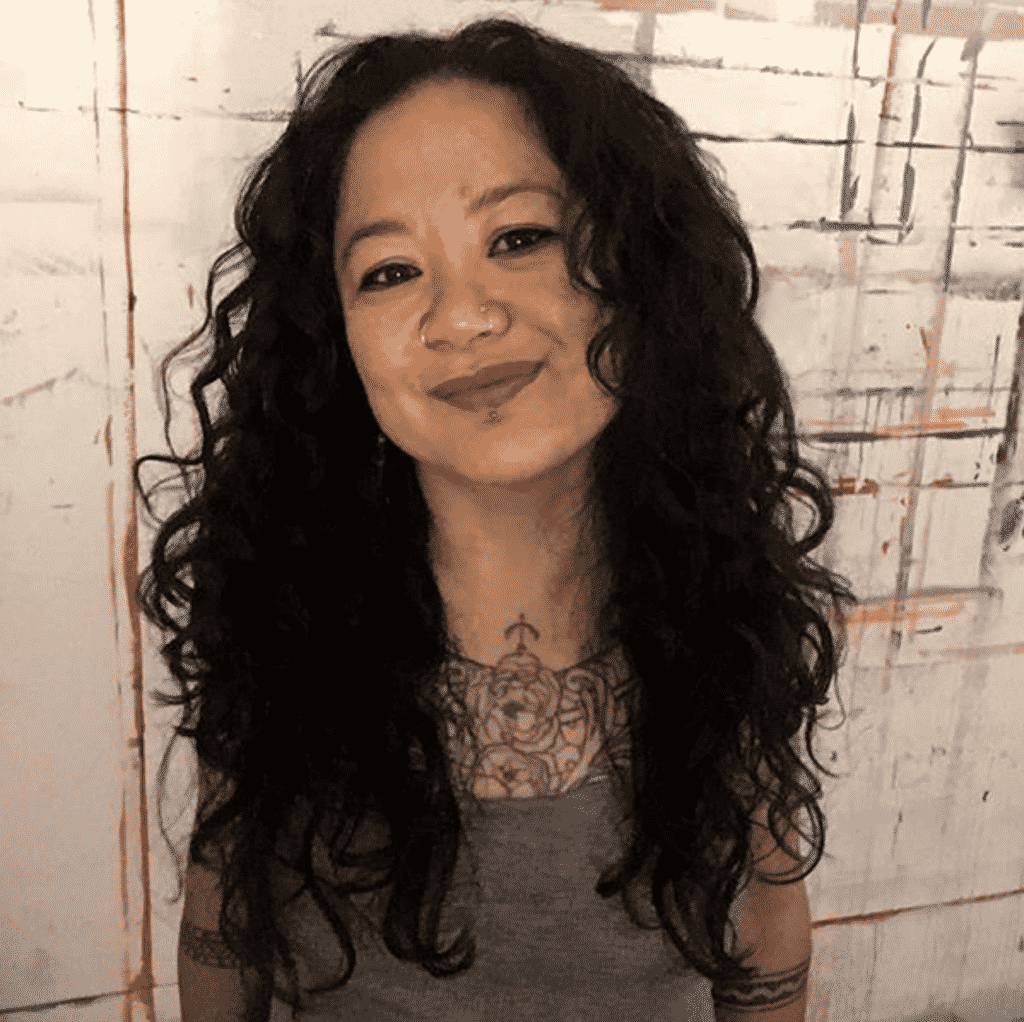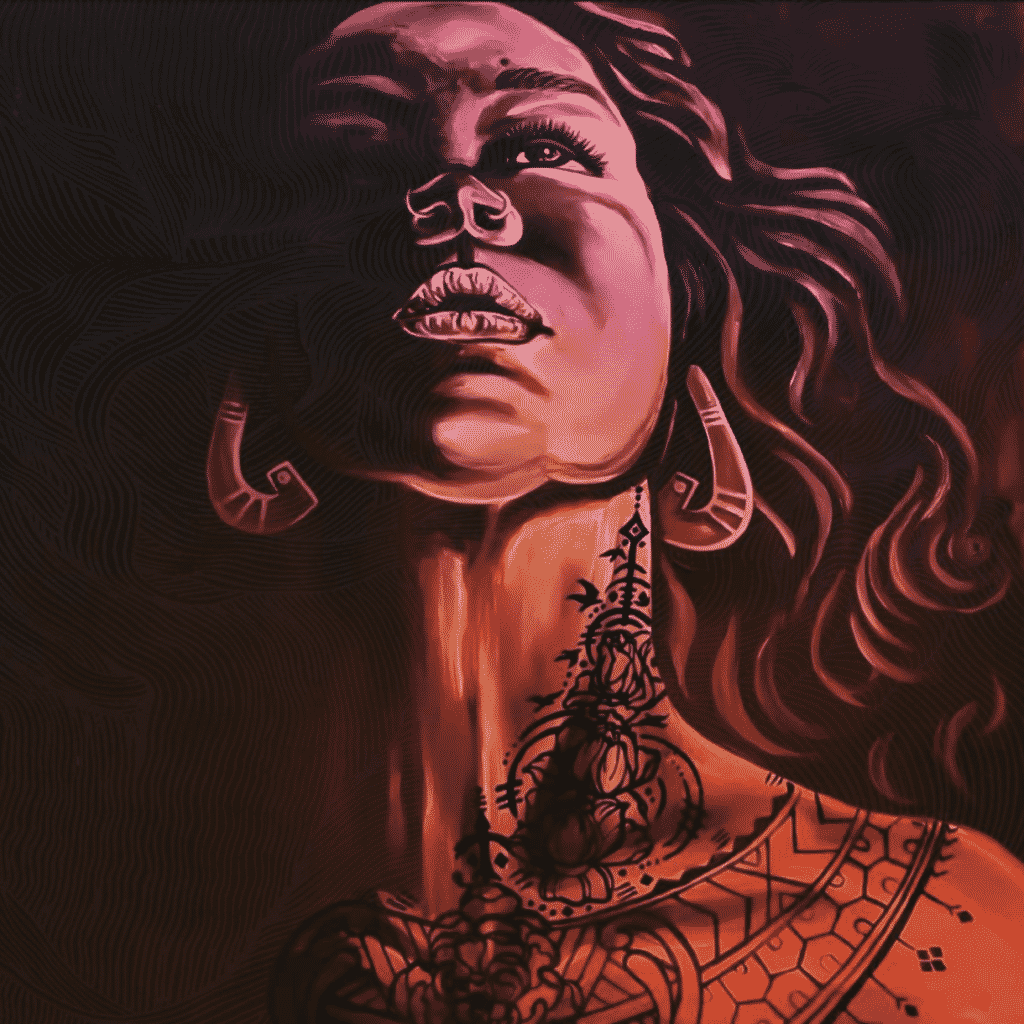
With a little acrylic, ink, and spray paint, Cece Carpio creates moving portraits of everyday people in her community. As an indigenous woman from the Philippines, Cece uses folkloric forms, bold portraits integrating natural elements, and urban art techniques to tell stories of immigration, ancestry, resistance, and resilience.
Cece’s work is featured in All Bodies Deserve: Creating the Future of Us a coloring book produced with the Center for Cultural Power through our Culture Change Fund. We are celebrating and spotlighting artists and creatives taking up space and helping us imagine a reality brimming with beauty, vitality, and gender justice.
Through each sketch, we can get a little closer to our feminist future. Cece joined Bia Vieira for a conversation and reflection on identity, place, culture, and the many stories that still have to be told.
Below is a transcript of their conversation that’s been edited for clarity.

Vieira: Do you want to talk about what attracted you to the Gender Justice Coloring Book project?
Carpio: Well, when the Center of Cultural Power reached out to me to be part of this project, it seemed like a real perfect fit for what it is that I do.
I center my work around working-class communities of color and as a woman of color, my artistic practice is it’s about uplifting our communities. Making sure that we are seen and that we exist and that we are here.
Many times our stories are not told. We still live in a very hetero-centered capitalist society. So a lot of our stories, a lot of our voices, a lot of our faces are made invisible in this semi-mainstream kind of depiction of what humanity is and how we should be. So it just seemed like a perfect fit. To join other artists to publish this book, showing kind of a true, real different way of how people can be seen and should be seen and should be lifted.
Vieira: Thank you, would you like to share a little bit about your creative process for your images that were published in the book?
Carpio: I wanted to display what abundance means in terms of how it looks different from different people. This is my interpretation, which is having food to eat, having a house to live in, having clean air, and having lands and cultures and traditions.
Especially with a person like myself who is part of the diasporic wave of immigrants um coming into this country, sometimes can still feel very foreign. But being able to practice our cultures and our traditions and being able to eat our food and in community and on land and nature with folks coming from different backgrounds.
That’s what the Bay Area represents for me as this place of abundance of cultures and abundance of history and abundance of movements that allowed us to be here. And allowed us to not only survive but really thrive. And all the different things that we do and all the different things we’re part of it, all the different traditions that we practice. This was my attempt to represent the vision of the world that we are trying to create in terms of, you know, the struggles and the fight that we go through but essentially having a destination in the world that we are walking towards.
Vieira: And what about your second image?
Carpio: This was happening kind of in the summer of last year, especially when the world kind of felt the inevitable uprising of Black Lives Matter and the racial reckoning that’s happening in this nation. It’s a depiction of solidarity between indigenous and… and Black communities. For me, for example, as an indigenous woman from the Philippines wanting to give honor to the indigenous people of this land, the Ohlone. But also recognizing the moment in time in which this was being created was such a potent moment in terms of racial reckoning that’s been long overdue and still continues now. At this moment, it’s still a big fight for many of us, and wanting to really show that we got each other, we got us. Our fight and our struggles might look different, but we can only win if we do it together and we can only rise if we rise together.
Vieira: Do you want to share a little bit about your journey to becoming an artist and how you think about um the work, the bringing in social issues into your art, or your life as an artist? however, you want to.
Carpio: Well, I grew up, as in the Philippines with my great grandmother who was illiterate and drawing for me, it has always been, and even at an early age, has been a form of communication and something I used a lot with her. Because when I went to school and would come back, she couldn’t read, but I could draw pictures. I find that to be very much the same within my journey as an adult. Having the opportunity and privilege to travel to different parts of the world where I didn’t speak the same language or doing collaboration work with communities with different literacy levels, different artistic levels. I found that pictures, you know what they say is can say 1000 words, and that has been very true from my practice. People have asked questions and why do I choose to paint about social justice? And I don’t necessarily think of it as much of a choice.
I paint what I know, I paint what I’m surrounded by. I paint the communities and people I’m part of. It’s both a reflection of the world and where I live, but also it is how I engage with it. The work I create is part of the experiences I’ve been part of, communities I’ve been part of, and things that I’ve seen and things that I envision we could use and we can envision for what our future to be, you know?
I don’t know whether that’s a choice. I mean in some ways I guess it is, but in other ways it’s, it’s more… my reflections of, of the world and where we’re living in and also how I’ve learned to engage with it in the ways that sometimes it’s not always easy to do.
Growing up poor being an artist is not necessarily the number one choice people consciously make. But in so many ways I feel like it was something I’ve always done whether or not, it could be labeled professionally. It is, you know, a big huge part of my profession, but it was something that I’ve done not only to express myself but also to heal. And how to feel I’m connected and exchange with different types of folks and with different types of communities and how to communicate um where sometimes words just weren’t enough.
If that is what we call social justice then great. But I think essentially. All of those together have just been kind of the experience I’ve had and knowing that my experiences are a big part of a collective movement for women, for immigrants, or folks of color, for working-class people and those are communities in which I’m part of.

Vieira: Thank you. And what is something that you are working on now that you want folks to know about your work that I can direct them for it?
Carpio: We actually just finished a second exhibition over in Oakland at the Old Swan’s Market 500 10th street at Washington. I and Tommy Wong from Civic Design Studio helped organize approximately 20 different artists of Asian and Black descent to show solidarity and created mobile murals that turned into lanterns and are now in Madison Park in Oakland, Chinatown last month. And now they are the installed and reinstalled on the window displays throughout various businesses in old Oakland. That’s going to be a couple of months at least. Just this weekend, we help supported Palestinian-lead painting out on the streets to kind of really take a stand on what’s happening in Palestine right now and the hundreds of people who have been killed, including children and the violence that they’re dealing with.
That work was created right before the 10,000 people marching on the street demanding justice. And upcoming, I’m actually doing some work with Restore Oakland right here in the Fruitvale community and that should be coming up fairly soon along with a couple of walls that are about 100 ft tall. If you’re out in Tenderloin, should be happening fairly soon as soon as we finish the design. And a couple of other publications with the National Domestic Workers Alliance California.
Vieira: What are you doing with the National Domestic Workers Alliance California?
Carpio: I am working with imagery for what they are calling the ancestor cards honoring domestic workers, women workers throughout history. I mean that dates back to the previous centuries. What domestic workers look like through time. And they created this cohesive timeline along with videos, and educational toolkits that will accompany that. We’re kind of in the tail end of that project so that I’m creating visuals that are going to be on cards and posters of the individuals that we wanted to highlight.
Vieira: Thanks. Anything else you want to share?
Carpio: No, thank you for this opportunity, and definitely looking forward to seeing what other projects can rise because there’s so much to be said. There are so many stories still unheard and there’s still so much work to do. I’m glad that we are expanding communities and to be able to continue to support what it is that we do. That is not only making something pretty and beautiful but is also building awareness of so many stories that really do need to be heard. And I’m grateful for the support and definitely looking forward to, seeing all the various things that can happen in the future.
Vieira: Wow, that’s great. Thank you. It’s really wonderful to meet you.
Carpio: You too. I’m glad we made it happen.
About CeCe Carpio
Using acrylic, ink, aerosol, and installations, Cece Carpio tells stories of immigration, ancestry, collective movements, and our stories of resilience. She documents evolving traditions through combining folkloric forms, bold portraits and natural elements with urban art techniques. Living and working in the Bay Area, she is inspired by the cultural potency of communities of color and of the prominent history of social movements that have become influential expressions for the rest of the world to see. The unique and complex narratives in the Bay have been in the forefront of creativity invigorating popular culture and allowing communities to imagine and create another world possible. She paints everyday people who have been invincible in order to share their thriving presence and to show the dignity and power of their existence. As a visual storyteller, Cece paints to lift up her communities, share their stories and provoke the power of their imagination.
Cece has produced and exhibited work throughout the globe. She has been awarded the Rockwood Institute Fellowship, NYFA Immigrant Artist Fellowship, a teaching residency at Café R.E.D & La Botica Espacio Cultural at Xela, Guatemala, an artist residency with KulArts at SOMA and Asian Art Museum in SF, and a recent honoree with YBCA 100 2020. She has been commissioned by the City of Oakland, YBCA, UC Berkeley, and OMCA. She served as a Public Art Advisor for the City of Oakland and is currently working as the Galleries Manager for the San Francisco Arts Commission. She can often be found with her collective, Trust Your Struggle, teaching, and traveling around the world in pursuit of the perfect wall.
Check out more of Cece’s work at cececarpio.com